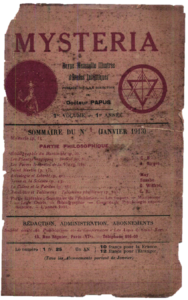A Human View of Saint-Martin
During my current efforts to translate and publish Saint-Martin’s and Papus’ works on Numbers, hoping to provide insight into the French approach to Numerology, I came across a long quotation by Papus in his book La Science des Nombres, in which he eulogizes a colleague, Albert Faucheux, who went by the nom-de-plume of Francois Charles Barlet. Born in Paris in 1838, and dying in 1921, he was an astrologer and occultist who knew Papus, Guénon, Peladan, de Guaita, Sédir, Chaboseau and others in that circle, writing a number of articles for l’Initiation and other magazines, as well as publishing books on astrology, among other subjects. He was a Grand Master of the Order Kabbalistique de la Rose-Croix, a member of the Supreme Council of the Order Martiniste, and was almost certainly a member of the Hermetic Brotherhood of Luxor run by his friend, Max Théon.
Sadly, the extract proved to be so pompous it frankly makes Waite look economical with his words… However, I was curious to locate the magazine it had been taken from, a review called Mysteria. I discovered that this was the monthly magazine started by Papus after l’Initiation had run its natural course in 1908 (until its revival by his son, Philippe Encausse, in the 1940s). It ran for only sixteen months, from January 1913 two May 1914. Given that Archduke Ferdinand was assassinated in June 1914, and with World War I breaking out a month later, it is hardly surprising that the Revue had such a short life. Unfortunately, the Revue is very dry, and one wonders whether it would have survived long in any case.
To my delight, I found all the copies on a wonderful website called The International Association for the Preservation of Spiritualist and Occult Periodicals (iapsop.com). To quote their website:”The IAPSOP is a US-based private organization focused on the digital preservation of Spiritualist and occult periodicals published between the Congress of Vienna and the start of the Second World War.” This site is indeed an amazing free resource containing both magazines from England, France, the US and elsewhere, and I highly recommend it. Browsing through earlier copies of Mysteria, I found an article buried in the first edition by Baron von Gleichen, describing his memories as a student of Sain-tMaritn and a colleague of Bacon de la Chevalerie and Hauterive. He quaintly spells Willermoz in a typically Germanic way: Villermoze! Sadly, two pages were missing from the fascinating article, leading me to assume a page had fallen out of the copy given to IAPSOP when they copied it and make it available online. No expecting a reply, I pointed this out in an email to the contact point for the organization.

Imagine my happiness to receive a reply only a few days later. In fact, not only was one of the researchers reviewing periodicals in a library in New York; they had come across the missing pages. As the researcher said, I should do a lottery ticket that day, since the chances of my question aligning so perfectly with a discovery of the missing pages in a library in NYC were next to zero! They have already added back the missing page to the online edition of Mysteria. My heartfelt thanks therefore go to Marc Demarest and John Patrick Deveney of IAPSOP for their diligence, and enthusiasm for their important mission.
The happy result is the attached document, a fascinating insight into the human beings with all their flaws who were Saint-Martin and his contemporaries, by one of his students. The portraits are very educational, and elicit a warm sense of sympathy for the very human people struggling with their emotions and their questions, and how to live in a changing society. It also answered – for me at least – some important questions. For example, if Saint-Martin’s father was so indulgent of his career changes, why was Louis-Claude so poor in the early stages of his career? We find this answered, as well as some personal insights into his relationship with his father. We learn how he was able to support himself in relative comfort, and why the formerly penniless aristocrat was later able to afford to give all the proceeds of some of his later republished books to the publishers.
Perhaps it is because the little about Saint-Martin and his contemporaries which has made it into English has tended to be about his teachings and his history. Till now there has been nothing about the players themselves, how they thought, what they thought of each other, how they lived from day to day, the petty squabbles, and so forth. This article provides a side to them which has previously been missing in the English world: what they were really like.
Here is the Memoir (click name to open): Saint-Martin-by-Gleichen



No Comments